Thursday’s New Moon Holds a Hybrid Solar Eclipse and Lyrids Light Up Moonless Evenings Filled with Venus and Galaxies Galore!
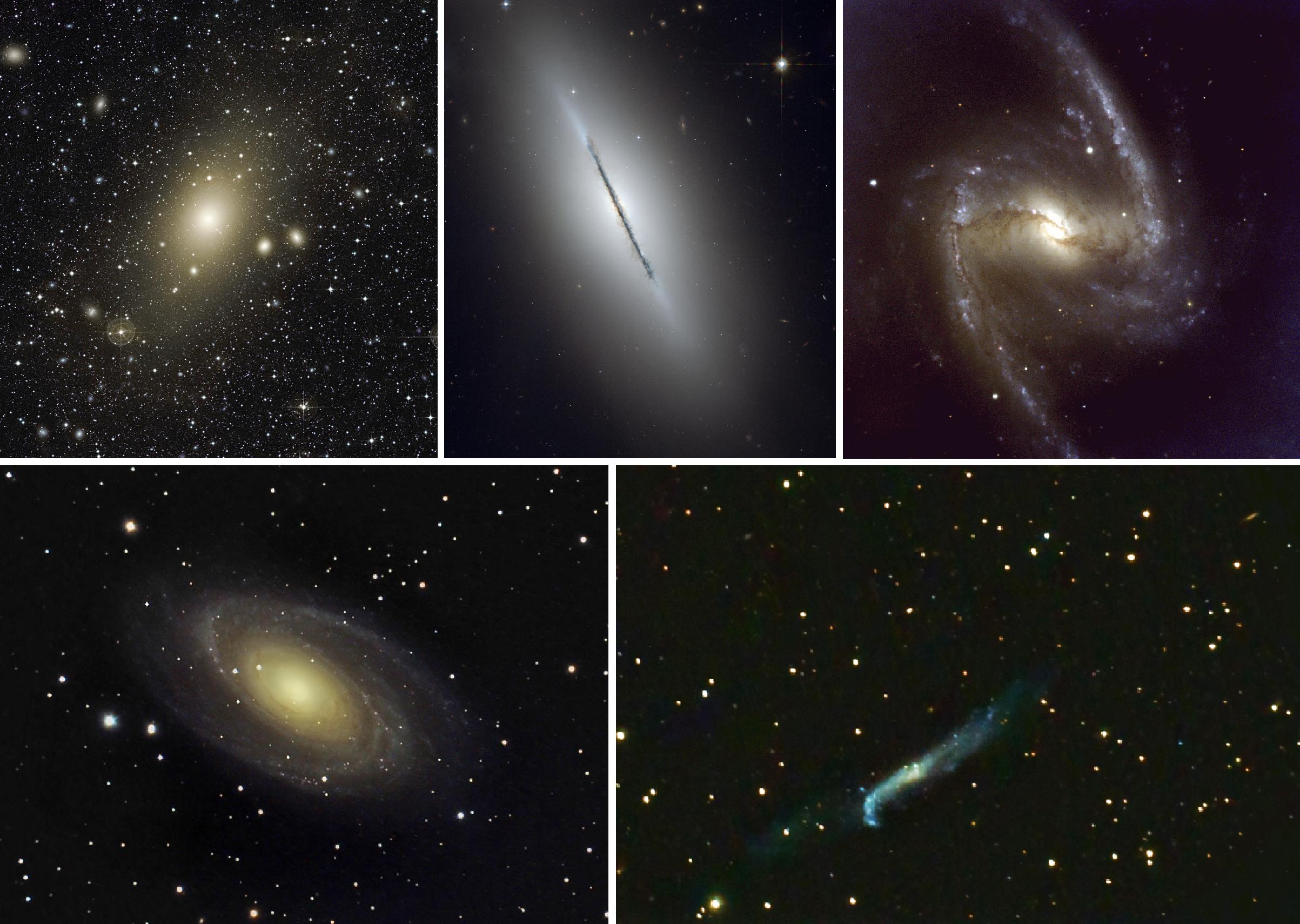
A sampling of galaxy forms. Clockwise from upper left: Messier 87 “Virgo A” (elliptical), Messier 102 “Spindle” (lenticular), NGC 1365 (barred spiral), NGC 4656 “the Crowbar” (irregular), and Messier 81 “Bode’s Nebula” (spiral). All except NGC 1365 are visible on spring evenings from mid-northern latitudes.
Hello, Meteor and Galaxy lovers!
Here are your Astronomy Skylights for the week of April 16th, 2023 by Chris Vaughan. Feel free to pass this along to your friends and send me your comments, questions, and suggested topics. You can also follow me on Twitter as @astrogeoguy! Unless otherwise noted, all times are expressed in Eastern Time. To subscribe to these emails please click this MailChimp link.
If you’d like me to bring my Digital Starlab portable inflatable planetarium to your school or other daytime or evening event, or deliver a session online, contact me through AstroGeo.ca, and we’ll tour the Universe, or the Earth’s interior, together! My terrific book with John A. Read entitled 110 Things to See With a Telescope is a guide to viewing the deep sky objects in the Messier List – for both beginners and seasoned astronomers. DM me to order a signed copy!
The moon will cross paths with the sun, literally on Thursday, delivering a hybrid solar eclipse for observers around Indonesia. That means the moon won’t contaminate evening skies worldwide with light until it returns on the coming weekend, allowing us to enjoy more spring galaxies and Lyrids meteors. Meanwhile Venus and Mars say goodbye to Mercury and Uranus in evening and Saturn climbs the predawn-east. Read on for your Skylights!
The Arch of Spring
A prominent winter asterism persists into April. During early evening the Winter Hexagon is tilting over the western horizon. Also known as the Winter Circle and Winter Football, it is composed of (moving anti-clockwise from the bottom left) bright white Sirius (Alpha Canis Majoris), blue-white Rigel (Beta Orionis), orange Aldebaran (Alpha Tauri), yellow Capella (Alpha Aurigae), white Castor and golden Pollux (Alpha and Beta Geminorum respectively), and white Procyon (Alpha Canis Minoris).
Some people use the top stars of the Winter Hexagon to make another pattern called the Arch of Spring. Eliminate Rigel and Aldebaran, add the fainter star Menkalinan near Capella, and continue the curve past Capella to the bright star Mirfak in Perseus (the Hero). This year, the arch is playing host to Mars and Venus!

Lyrids Meteor Shower
The annual Lyrids Meteor Shower will peak in intensity at approximately 9 pm EDT on Saturday, April 22 – but more meteors will be seen once the shower’s radiant point near the bright star Vega in the constellation of Lyra (the Harp) climbs higher in the sky in the early hours of Sunday morning, April 23. This year, no moonlight will spoil the shower!
Meteor showers occur when the Earth passes through zones of debris shed by repeated passages of periodic comets with orbits that intersect Earth’s. (An analogy would be the material tossed out of a dump truck as it rattles along. The roadway gets pretty dirty if the truck drives the same route a number of times!) Over centuries and millennia, the dust-sized and sand-sized particles accumulate in a zone that surrounds the comet’s orbit, with their distributions denser along the orbit and tapering off in the zone around it.
While the Earth plows through one of those clouds of cometary debris, the particles are pulled in by our gravity and zip through our atmosphere at speeds on the order of 200,000 km/hr. The grains moving that fast through the air generate intense heat that ionizes the air in a long, narrow tube surrounding the particle’s track – producing the long, glowing trails we see as meteors.

The duration of a particular meteor shower depends on the width of the debris cloud and whether the Earth moves across it perpendicularly, or performs a longer, oblique crossing. The shower’s intensity depends on whether we pass through the densest region, or merely skirt its edges. Since the Earth passes through the same part of the solar system on the same date every year, meteor showers repeat annually. Fluctuations in the geometry of the encounter can cause showers to vary from their predicted behavior – and even produce unexpected outbursts in some years.
The source particles for the Lyrids shower is thought to be a comet named C/1861 G1 (Thatcher), after its discoverer A. E. Thatcher. It orbits the sun every 416 years, shuttling between the distant Kuiper Belt (110 times farther from the sun than we are) and just inside Earth’s orbit. Comet Thatcher’s orbit is at right angles to the planets’ orbits. It is expected to dive across the plane of the inner solar system next around the year 2283. You can manipulate a 3D model of the orbits here.
Meteor showers ramp up and then taper off during their active periods. For the Lyrids shower that’s April 16 through April 25. Start looking up now – I already saw a bright one last Thursday night! Expect up to 10-20 Lyrids meteors per hour at the peak – some manifesting as bright, sputtering fireballs! According to NASA, the Lyrids were documented by Chinese astronomers in 687 BCE – making this one of the oldest recorded meteor showers.
Usually, meteor showers are best observed in the dark skies before dawn, because that’s the time when the sky overhead is plowing directly into the oncoming debris field, like bugs splattering on a moving car’s windshield. The direction in the sky that is Earth is travelling towards (or the road ahead, to use my car analogy) is called the radiant. All the meteors from a particular shower’s source will seem to be travelling away from, or radiating, from that location. The constellation containing the radiant gives the shower its name. Long ago, the Lyrids radiant was located in the constellation of Lyra (the Harp), near the bright star Vega. Over time, the slow wobble of Earth’s axis has shifted the radiant into next-door Hercules.
If you begin to watch after dark on Saturday evening, you might catch a few spectacular, very long meteors that are skimming the Earth’s upper atmosphere. As the night rolls on, the radiant will rise higher in the sky, revealing more meteors because they will no longer be hidden by the bulk of the Earth. Normally, the absolute best time to watch is when the radiant is almost overhead, between 4 and 5 am in your local time zone.
For best results, try to find a safe viewing location with as much open sky as possible. You can start watching as soon as it gets dark. Don’t bother watching the radiant. Meteors near there will be heading directly towards you and will have very short trails. But do try tracing the meteors backwards to their source.
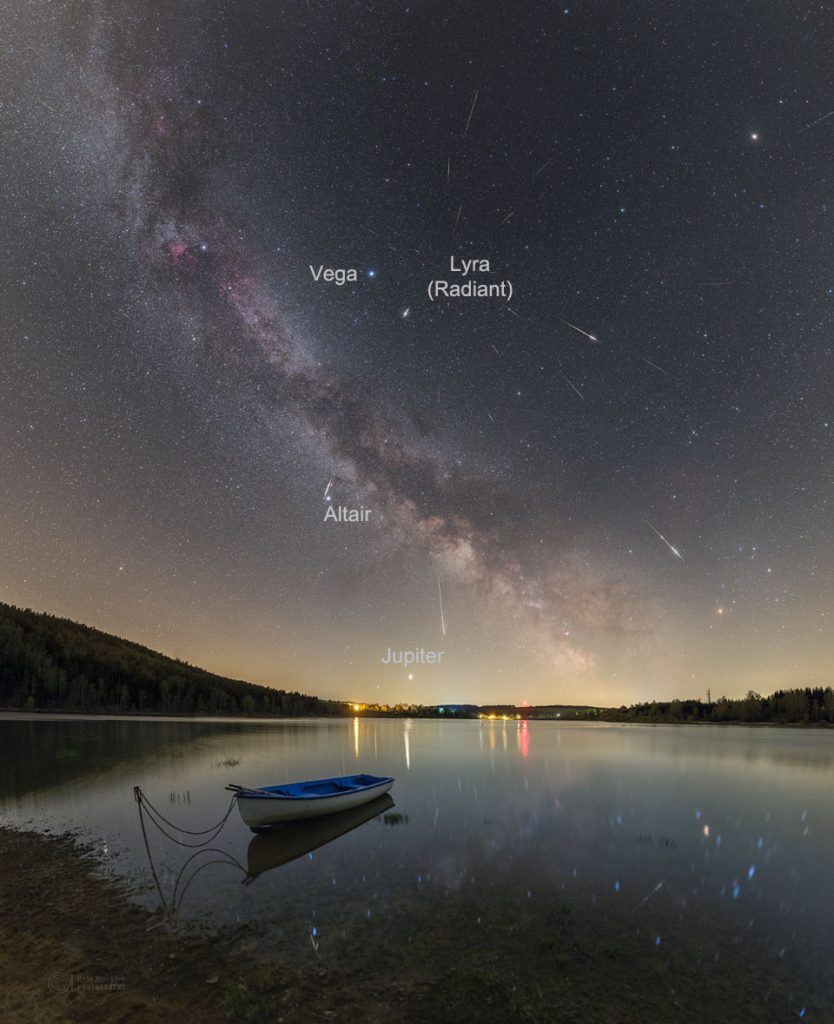
Bring a blanket for warmth and a chaise to avoid neck strain, plus snacks and drinks. Try to continuously watch the sky, even when chatting with friends or family – they’ll understand. Call out when you see one; a bit of friendly competition is fun! You’ll also see plenty of satellites gliding silently and smoothly across the sky. (Airplanes have lights that flash while satellites emit a steady (or sometimes slowly pulsing) glint of reflected sunlight.)
Keep your phone or tablet tucked away – its bright screen will spoil your dark adaptation. If you can’t resist some screen time, minimize the brightness and/or cover the screen with red film. Disabling app notifications will reduce the chances of unexpected bright light, too. And remember that binoculars and telescopes will not help you see meteors because they have fields of view that are too narrow. Good luck!
By the way, the nickname for meteors is “shooting stars” or “falling stars”. But meteors bear no physical connection to the distant stars at all. All of your favourite constellations will look the same as ever at the end of the shower!
The Moon and a Hybrid Solar Eclipse
Early risers on Monday morning might spot the old crescent moon shining just above the east-southeastern horizon for a short time before the sunrise brightens the sky too much. Watch for the yellowish dot of Saturn shining well off to the moon’s upper right. Theoretically, an even thinner crescent moon will be visible on Tuesday morning, too. In both cases, the moon will be far easier to see if you live closer to the tropics.
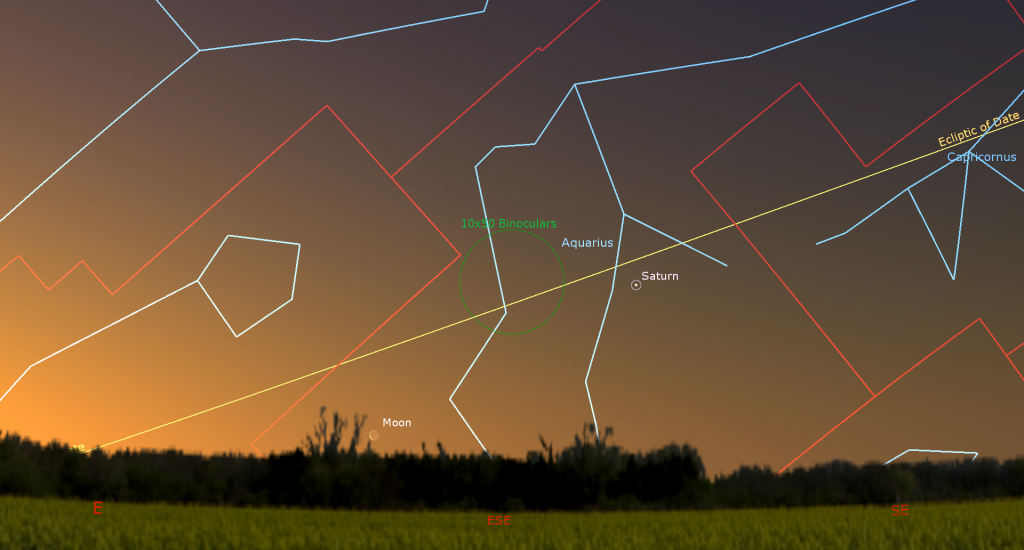
That morning moon means that bright Venus will be the only celestial object around to spoil the evening sky, the spring galaxies that populate it, and the Lyrids meteor shower. Thankfully, Venus is positioned on the opposite direction from those galaxies, and it drops below the treetops before too long, anyway.
On Thursday, April 20 at 12:12 am EDT or 04:12 Greenwich Mean Time, the moon will officially reach its new moon phase. (That converts to 9:12 pm PDT on Wednesday, April 19.) While new, the moon is traversing the space between Earth and the sun. Since sunlight is only shining on the far side of a new moon, and the moon is in the same region of the sky as the sun, our natural satellite becomes completely hidden from view for about a day – unless a solar eclipse occurs!
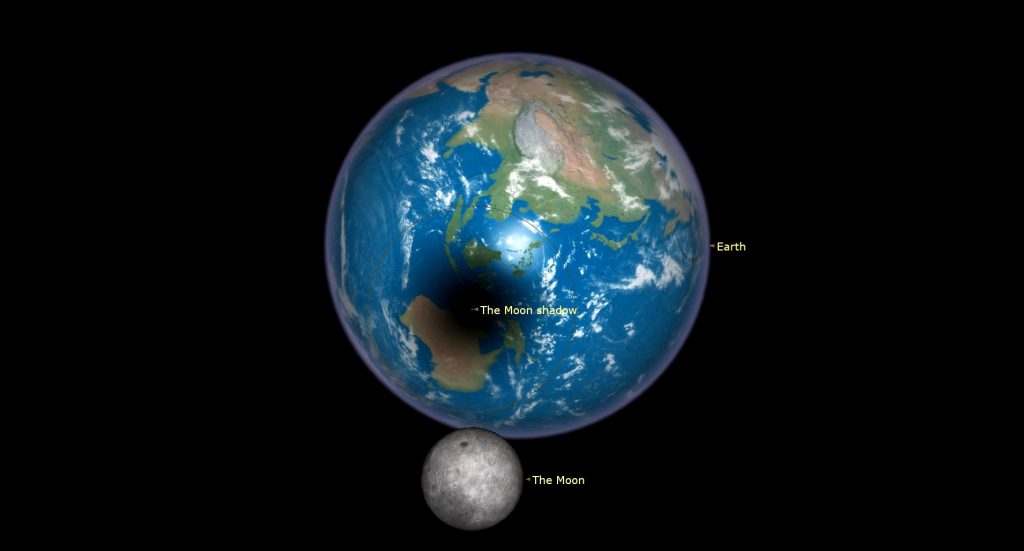
This new moon will also generate a rare hybrid solar eclipse – a type that occurs several times per century. On Thursday morning, the sun will be partially eclipsed for an area encompassing Australia, Indonesia, northern New Zealand, and much of the western Pacific Ocean. Observers within a very narrow track that crosses the Ningaloo Coast of western Australia, Timor-Leste, and West Papua, Indonesia will see a total solar eclipse for about one minute. Toward the extreme east and west ends of the umbral track a thin annular eclipse will be seen instead. An annular eclipse occurs when the moon is farther from the surface of the Earth. Its smaller apparent size makes it unable to completely cover the sun, leaving a ring of exposed sun around the moon. For this eclipse the curvature of the Earth will allow the Earth’s surface to be close enough to the moon to completely block the sun only for the middle third of the total track length.
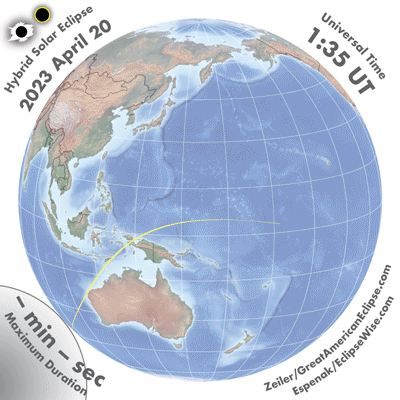
You can use an app to determine the eclipse visibility and timings at your location. Astronomers call that the eclipse circumstances. Always wear proper solar filters when viewing a solar eclipse in person. Timeanddate.com will be streaming the solar eclipse live, which you can watch here.
You might be able to see the freshly minted young crescent moon lingering above the west-northwestern horizon for a short time after sunset on Thursday. If you do spot it, pat yourself on the back. Very few people have seen the moon less than a day past new!

You will definitely be able to see the moon from Friday onward. As the sky begins to darken after sunset on Friday, the slender crescent of the young moon will shine prettily. Watch for Earthshine on the moon. Sometimes called the Ashen Glow or the Old Moon in the New Moon’s Arms, the phenomenon is visible within a day or two of new moon, when sunlight reflected off Earth and back toward the moon slightly brightens the unlit portion of the moon’s Earth-facing hemisphere. Sharp-eyed skywatchers may be able to spot the dot of magnitude 2.36 Mercury positioned a slim fist’s width to the lower right (or 8 degrees to the celestial west) of the moon. The much fainter planet Uranus will be located several finger widths to the left of Mercury – close enough for the two planets to share the field of view in binoculars. Mercury and Uranus will set an hour before the moon. The pretty Pleiades star cluster will follow the moon down.
The western sky after sunset on Saturday will host the spectacular sight of the young moon’s delicate crescent posing between the brilliant planet Venus and the Pleiades – making a terrific photo opportunity. The bright orange star Aldebaran and the Hyades cluster, that together form Taurus’ face, will sparkle off to their left (or celestial south). Watch for Earthshine again. The moon will end this week positioned above Venus.
Spring Galaxy Fun Continues
Last week here I wrote a guide to the best and brightest spring galaxies and why we can see them so well nowadays. The fun continues this week while the moon remains out of the way. Let’s talk about how we use the various shapes the galaxies have to classify them and understand how they came to be.
During early 1920’s at Palomar Observatory in California, astronomer Edwin Hubble was using the recently discovered Cepheid variable star period-luminosity formula to estimate the dimensions of our Milky Way galaxy. Cepheid variable stars vary in brightness with a period of time that is in direct proportion to their true (or intrinsic) brightness. By comparing how bright the star appears with how bright it actually would be if you were a specified distance from it, astronomers could estimate how far away that star is and build up a framework for the shape and size of our galaxy.
At the time, before large telescopes were available, astronomers did not know that many of the fuzzy patches they were observing in the sky were objects outside of our galaxy; that they were completely other galaxies. They just called them “nebulas”. When Hubble found Cepheids in some of those “nebulas”, such as the one we now call the Andromeda Galaxy (Messier 31), and calculated their distances, he was astonished. Knowing how large our Milky Way galaxy is, he realized that those nebulas must be other galaxies unto themselves!

Starting in 1926, Hubble began to classify galaxies into four styles, based upon the way they look in photographs and through a telescope. He used the terms elliptical (E), lenticular (SO), spiral (S), and irregular (I). Elliptical galaxies are rather dull-looking clumps of stars ranging from round (E0) to highly stretched (E7). But they are now known to be enormous – the product of multiple galaxies merging together and losing their original structures. Each elliptical seems to host a supergiant black hole in the centre. Our Milky Way galaxy and the Andromeda Galaxy will merge in several billion years, probably producing a new elliptical galaxy.
Spiral galaxies have a central core with arms wrapping around it in a flattened disk. The arms can be large or small, and loosely or tightly wound. There can be many arms, or as few as two. The central core can be round or elongated. Needing a way to manage all these differences, Hubble developed the Tuning Fork scheme, where one tine held the round-core spirals (the SA type), sorted by the tightness of their arms. The other tine did the same for galaxies with elongated, or barred, cores (the SO type). He added the letters “a” to “c” to indicate how tightly wound they were.
The ellipticals formed the handle of the fork. Where the fork split, Hubble placed the lenticular galaxies. Those have a central core but no apparent spiral arms, possibly because they have “relaxed” their arms with age – more like a Frisbee than an octopus.
Starting in 1959 French astronomer Gérard de Vaucouleurs and American astronomer Allan Sandage refined Hubble’s system. They added a middle branch for intermediate spirals (SAB type), and lengthened the tines with “d” for very loosely wound, plus “m” for a single arm (i.e., barely a spiral at all). At the far end he placed the leftovers, irregular galaxies. Those are probably gravitationally distorted versions of normal galaxy types.
We classify galaxies based on how they look from Earth, so there’s ambiguity, especially if they are seen edge-on. We can use spectroscopy and images taken at other wavelengths of light to peer inside galaxies and determine their form – even the edge-on ones. The galaxy’s classification codes are often displayed in programs and apps like Stellarium, SkySafari, and Starwalk 2.
Tips for Galaxy Viewing
If this week is filled with cloudy evenings for you, as it is for me, don’t worry. Many of the spring galaxies can be viewed in May and June, too. And there are always at least some around. Here are some tips for finding and viewing galaxies. Start off with a good sky chart or app that shows the prominent stars around your quarry. My 110 Things to See With a Telescope book with John A. Read has easy charts for many dozens of them.
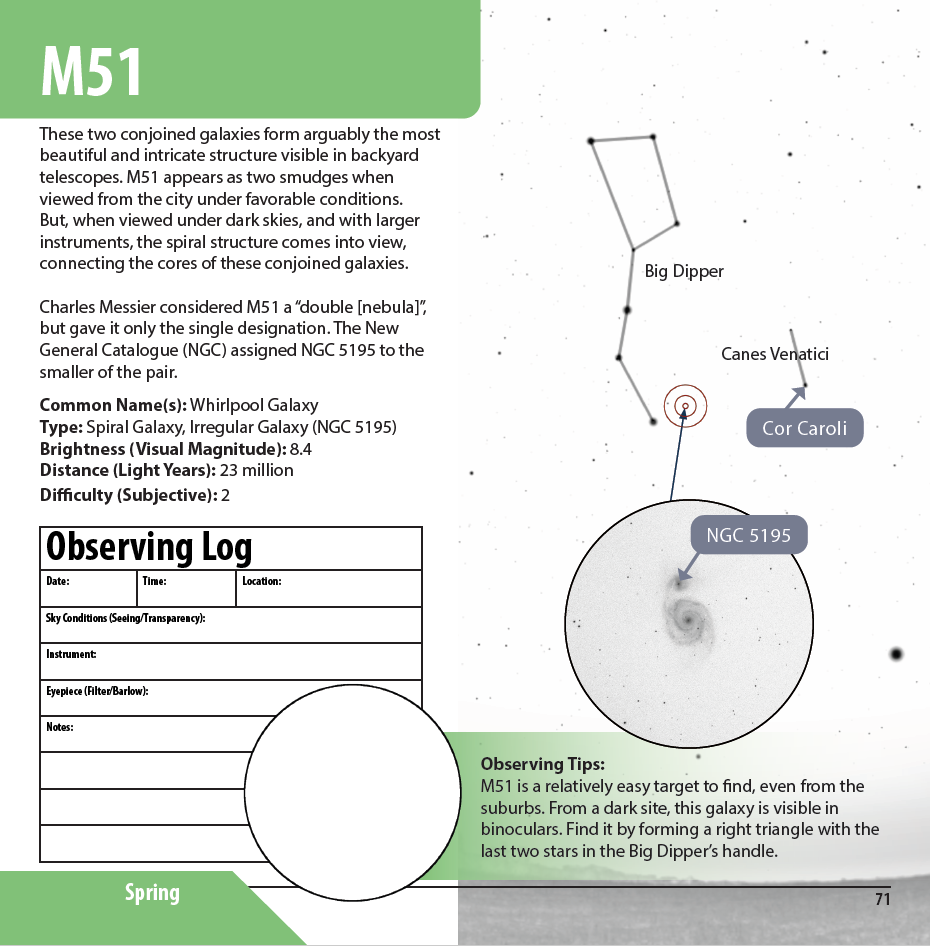
A dark, clear, and transparent sky is the key for success with galaxies! Choose cloud-free, moonless nights (from third quarter to new moon phase each lunar month) and a viewing site away from artificial lights and the city light domes that wash out the night sky. Humid air can dim faint objects, too – as can forest fire smoke and dust. To maximize your eyes’ ability to see faint galaxies, avoiding looking at white light sources for at least half an hour in advance, including car headlights, flashlights, and phone and tablet screens. Dim, red light won’t spoil your dark adaptation. Cover device screens with red film. If you plan to make notes at the eyepiece, use a red headlamp or flashlight. I even cover one white notebook page with dark paper while I write on the opposite page, to reduce the glare. I recently purchased a pair of the red plastic goggles laser technicians use. They work great for preserving your dark adaptation between looks in the telescope.
You can also maximize your eyes’ sensitivity by learning to use averted vision when looking through a telescope. The technique involves drawing your attention towards the edge of the eyepiece’s field of view and let your peripheral vision pick up the faint galaxy in the middle. It works because the most sensitive light receptors in your eyes aren’t the central ones. For the best visual acuity, avoid consuming alcohol before observing, try to be comfortably seated, and breathe deeply to oxygenate your eyes.
If you can’t see the galaxy at first, tap the telescope while viewing through it. Faint objects that are in motion will draw your attention better – again by using different eye receptors and brain pathways. If objects seem dimmer than expected, check that you don’t have dew or frost on your lenses and/or mirrors. At home, a hair dryer set to cool and waved across the optics from 30 cm away can clean things up. A 12v blower/fan for camping can work, too. Strapping a chemical hand warmer around the underside of your telescope can help, in a pinch.

For telescope users, always start searching for galaxies with your lowest power, longest focal length eyepiece. I like a combination that gives me a 1.5° field of view, or three times the moon’s diameter. Once you have the target, note your initial impressions, and then swap in stronger eyepieces to enlarge it. Go easy on zooming in, though. Remember that many galaxies are quite large – a substantial fraction of the moon’s diameter – and you may notice more if they aren’t too spread out under high power!
Faint objects are tough to see in small aperture finder scopes. For searching, I recommend replacing the magnifying finder scope with a Telrad Reflex Sight or another non-magnifying (1X) finder that projects dim red bull’s-eye rings onto a window that you look through while pointing the telescope. Those are terrific because you can always see the brighter stars around the galaxy. Just place those telrad rings on or between nearby bright stars. By the way, it’s a good idea to use stars near your galaxy to focus the telescope before you look for the galaxy itself.

If you are using a star atlas or an app to find your galaxy, remember that the view in the eyepiece will probably be flipped and/or mirror-imaged. Newtonian reflector telescopes (the big cannon-type) rotate the binoculars view by 180 degrees. With them, just turn the book upside down to match the eyepiece view! Refractor telescopes and Schmidt-Cassegrain telescopes (SCT) that use a right-angle mirror to hold the eyepiece will mirror-image the regular scene. It’s helpful to know the expected field of view delivered by your searching eyepiece, too. Some people like to make FOV circles to overlay on paper atlas pages. The better astronomy apps will let you display FOV circles and to flip the display to match your telescope.
If the galaxy you are chasing is not conveniently located near any reference stars, you can start at the best star available and then “star-hop” following recognizable star patterns. Place distinct asterisms at the edge of the FOV opposite to your target. Later, note which stars you hopped to in your observing log. Remember to account for the flipped / mirror-imaged directions.
Finally, filters will not help for visual galaxy-observing! Galaxies emit starlight, and you want as much of that as you can get!
The Planets
The brilliant planet Venus will grab your attention in the western sky after sunset on every clear evening. Our sister planet will be with us until summer. As the sky begins to darken Venus will appear one third of the way up the western sky. Before long the darkening sky will reveal the brightest stars of Taurus (the Bull) around it, especially reddish Aldebaran to its lower left (celestial south) and the Pleiades Star Cluster to Venus’ lower right (or celestial west). Venus will descend and set around 11:45 pm in your local time zone. Viewed in a telescope this week, Venus will display a gibbous 71%-illuminated disk that is waning daily. To see Venus’ shape most clearly in a telescope, view the planet as soon as you can locate it through your optics, when it will be higher and shining through less intervening air.

After its star turn earlier this month, the swift planet Mercury is dropping sunward each night – but you might glimpse its medium-bright dot shining just above the horizon around 9 pm local time for the first few days of the is week. The much fainter planet Uranus will be located a few finger widths to Mercury’s left (or celestial southeast) – but seeing it will pose a challenge.
The only other evening planet to enjoy is Mars. The planet continues to fade in brightness and become smaller in telescopes as Earth increases its distance from the red planet. After dusk tonight (Sunday), the red-tinted dot of Mars will appear in central Gemini (the Twins), about two-thirds of the way up the west-southwestern sky. That will be its best telescope viewing time – while it’s perched on high – but it will look tiny under any magnification. Reddish Mars will form a large triangle above bright red Betelgeuse at Orion’s shoulder and well to the upper left of the bright, reddish star Aldebaran, which marks the angry eye of Taurus (the Bull). The planet will set during the wee hours of the night.

Mars’ easterly orbital motion on the northern side of the ecliptic continues to help it to delay its inevitable descent into the west until July. To see its motion for yourself, note its position with respect to the nearby star Mebsuta every few nights. Tonight Mars will shine to the upper left (or celestial southeast) of somewhat less bright Mebsuta. Their spacing will grow each night.
If you are outside at 5:30 am local time and you have a clear view of the east-southeastern horizon, watch for the yellowish dot of Saturn shining among the faint stars of Aquarius (the water-Bearer).
Public Astro-Themed Events
Every Monday evening, York University’s Allan I. Carswell Observatory runs an online star party – broadcasting views from four telescopes/cameras (weather permitting), answering viewer questions, and taking requests! Details are here. They host in-person viewing on the first clear Wednesday night each month. On Wednesdays they stream views online via the observatory YouTube channel. Details are here.
On Tuesday, April 18 at 6:30 pm at Deer Park Public Library, 40 St. Clair Avenue East, Toronto, the University of Toronto Emeritus Professor of Astronomy John Percy will present a free public talk entitled From Everyday Life to the Big Bang. Details are here.
At 7:30 pm on Wednesday, April 19, the RASC Toronto Centre will livestream their free monthly Speaker’s Night Meeting. This month, the speaker will be Dr. Haley M. Sapers, Ph.D., Research Associate, Dept. of Earth and Space Science and Engineering, York University and Visiting Scientist,California Institute of Technology. Her topic will be Intraterrestrial to Extraterrestrial: Deep Subsurface Microbial Communities and (Searching for) Life on Mars. Check here for details. Watch at https://www.youtube.com/rasctoronto/live.
My free, family-friendly Insider’s Guide to the Galaxy webcast with RASC National returns on Tuesday, April 25 at 3:30 pm EST. We’ll de-mystify the magnitude and brightness scale that astronomers use to measure and report how bright things are and how they look. Then we’ll wrap up by highlighting our next batch of spring RASC Finest NGC objects. You can find more details and the schedule of future sessions here.
Keep looking up, and enjoy the sky when you do. I love questions and requests. Send me some!